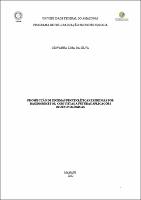| ???jsp.display-item.social.title??? |


|
Please use this identifier to cite or link to this item:
https://tede.ufam.edu.br/handle/tede/9254| ???metadata.dc.type???: | Dissertação |
| Title: | Prospecção de enzimas proteolíticas expressas por basidiomicetos, com vistas à futuras aplicações biotecnológicas |
| Other Titles: | Prospection of proteolytic enzymes expressed by basidiomycetes, aiming at future biotechnological applications Prospección de enzimas proteolíticas expresadas por basidiomicetos, con vistas a futuras aplicaciones biotecnológicas |
| ???metadata.dc.creator???: | Silva, Giovanna Lima da  |
| ???metadata.dc.contributor.advisor1???: | Sales-Campos, Ceci |
| First advisor-co: | Chevreuil, Larissa Ramos |
| ???metadata.dc.contributor.referee1???: | Araujo, Lidia Medina |
| ???metadata.dc.contributor.referee2???: | Fariña, Julia Inés |
| ???metadata.dc.description.resumo???: | O uso de macrofungos (cogumelos) como alimentos e/ou medicamentos apresenta longa tradição pelos povos asiáticos, devido às suas propriedades nutricionais e medicinais. Nos últimos anos, com a ascensão tecnológica, muitas moléculas biologicamente ativas isoladas de macrofungos têm sido avaliadas quanto à sua eficiência sobre o tratamento de algumas doenças e/ou outras aplicações biotecnológicas. Contudo, no cenário Amazônico, pouco se conhece acerca dos macrofungos, bem como seu potencial em produzir moléculas bioativas. Assim, esse trabalho objetivou prospectar proteases e enzimas fibrinolíticas nos micélios de macrofungos, quando cultivados em diferentes meios de cultura, de modo a verificar qual espécie e/ou linhagem apresenta maior potencial de síntese dessas proteínas, visando futuros estudos envolvendo produção e aplicação dessas moléculas na área da saúde. Os macrofungos Auricularia sp., Ganoderma lucidum, G. tropicum, Grifola frondosa, Lentinus strigosus, Macrocybe sp. e linhagens de Pleurotus ostreatus (474, 542 e 885) foram cultivados em meio ágar-aveia (AA), ágar batata dextrose (BDA), ágar caseína (AC), ágar Czapek Dox (ACD), ágar farinha de soja (AFS), ágar malte (AM), MFI, MILK e MYSA. As hifas fúngicas foram submetidas à extração proteica e, posteriormente, realizados ensaios de determinação de atividades proteolíticas e fibrinolíticas. AA foi o meio de cultivo mais favorável ao crescimento da maioria das espécies fúngicas estudadas, principalmente, Pleurotus ostreatus 474 e Lentinus strigosus, atingindo crescimento máximo após quatro e cinco dias de cultivo, respectivamente. Auricularia sp. quando cultivada em AFS apresentou as maiores atividades de serino-proteases e proteases totais. Enquanto, P. ostreatus 885 exibiu maior atividade de proteases cisteínicas. O extrato de Macrocybe sp. em AFS exibiu a maior atividade fibrinolítica. Diante dos resultados obtidos, sugere-se que o meio AA foi o mais favorável para crescimento das espécies. Adicionalmente, todos os meios induziram a produção de enzimas proteolíticas, contudo, a produção de proteases fibrinolíticas foi promissora nos meios AFS, AM e MFI. Enquanto as espécies Lentinus strigosus e Macrocybe sp. destacaram-se pela produção de enzimas fibrinolíticas. |
| Abstract: | The use of macrofungi (mushrooms) as food and/or medicine has a long tradition by Asian peoples, due to their nutritional and medicinal properties. In recent years, with the rise of technology, many biologically active molecules isolated from macrofungi have been evaluated for their efficiency in the treatment of some diseases and/or other biotechnological applications. However, in the Amazon scenario, little is known about macrofungi, as well as their potential to produce bioactive molecules. Thus, this work aimed to prospect proteases and fibrinolytic enzymes in macrofungal mycelia, when cultivated in different culture media, in order to verify which species and/or strain has the greatest potential for synthesis of these proteins, aiming at future studies involving production and application of these molecules in the health area. The macrofungi Auricularia sp., Ganoderma lucidum, G. tropicum, Grifola frondosa, Lentinus strigosus, Macrocybe sp., and Pleurotus ostreatus strains (474, 542 and 885) were cultivated in oat agar (AA), potato dextrose agar (BDA), casein agar (AC), Czapek Dox agar (ACD), soy flour agar (AFS), malt agar (AM), MFI, MILK and MYSA. The fungal hyphae were submitted to protein extraction and assays were performed to determine proteolytic and fibrinolytic activities. MA was the most favorable culture medium for the growth of the fungal species studied, mainly Pleurotus ostreatus 474 and Lentinus strigosus, reaching maximum growth after four and five days of cultivation, respectively. Auricularia sp. when cultivated in AFS it showed the highest serine proteases and total proteases activities. While, P. ostreatus 542 exhibited higher activity of cysteine proteases. Macrocybe sp. in AFS exhibited the highest fibrinolytic activity. Therefore, it is suggested that the AA medium was the most favorable for the growth of the species. In addition, all media induced the production of proteolytic enzymes, however, the production of fibrinolytic proteases was promising in AFS, AM and MFI. While the species Lentinus strigosus and Macrocybe sp. stood out for the production of fibrinolytic enzymes. |
| Keywords: | Macrofungo Cogumelos - Cultivo |
| ???metadata.dc.subject.cnpq???: | CIENCIAS BIOLOGICAS |
| ???metadata.dc.subject.user???: | Macrofungos Cultivo sólido Compostos bioativos Enzimas fibrinolíticas |
| Language: | por |
| ???metadata.dc.publisher.country???: | Brasil |
| Publisher: | Universidade Federal do Amazonas |
| ???metadata.dc.publisher.initials???: | UFAM |
| ???metadata.dc.publisher.department???: | Instituto de Ciências Biológicas |
| ???metadata.dc.publisher.program???: | Programa de Pós-Graduação em Biotecnologia |
| Citation: | SILVA, Giovanna Lima da. Prospecção de enzimas proteolíticas expressas por basidiomicetos, com vistas à futuras aplicações biotecnológicas. 2022. 100 f. Dissertação (Mestrado em Biotecnologia) - Universidade Federal do Amazonas, Manaus (AM), 2022. |
| ???metadata.dc.rights???: | Acesso Aberto |
| ???metadata.dc.rights.uri???: | http://creativecommons.org/licenses/by/4.0/ |
| URI: | https://tede.ufam.edu.br/handle/tede/9254 |
| Issue Date: | 30-Nov-2022 |
| Appears in Collections: | Mestrado em Biotecnologia |
Files in This Item:
| File | Description | Size | Format | |
|---|---|---|---|---|
| Dissertação_GiovannaSilva_PPGBIOTEC.pdf | 4.99 MB | Adobe PDF |  Download/Open Preview |
This item is licensed under a Creative Commons License





